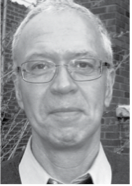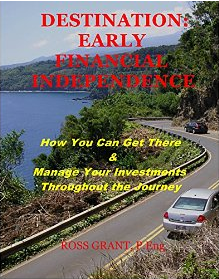BOOK REVIEW - "Destination: Early Financial Independence"
BOOK REVIEW - "Destination: Early Financial Independence"

"How You Can Get There & Manage Your Investments Throughout The Journey."
by Ross Grant. Amazon. 149 pp. (estimate).
C$5.95 (available only for download).
Ross Grant’s short book is a series of letters to one of his daughters, written when he was 50 years old. The letters describe how he and his wife achieved financial independence by the time he was 43, when they both retired. The book contains 26 letters about how they did it, with a charming letter in reply from his daughter, Katie Grant. There’s a strong Canadian MoneySaver link since Ross adopted David Stanley’s Beating the TSX strategy as his basic investment approach; David has now passed on BTSX to Ross.
The letters provide a clear-minded, well written and simple approach to financial independence. It helps that Ross is very good with numbers and Excel spreadsheets; he even itemizes the twenty tips he gives his daughter. It also helps that he and his wife are both engineers, and highly organized. Ross first started saving as a kid, from his early beginnings with a paper route and cutting lawns. By working hard and saving, he graduated from university with $10,000 in the bank. Later, when he had his first job, he shared an apartment with two others, thus splitting the fixed costs; needless to say, he took the smallest room and thus saved even more. When they bought their first house, he and his wife rented out the basement. Within a couple of years they bought another house, also with a rental basement, and then rented out the first house. Ross is good at doing minor renovations and home improvements. They paid off their mortgages by the time they were 35.
financial independence. It helps that Ross is very good with numbers and Excel spreadsheets; he even itemizes the twenty tips he gives his daughter. It also helps that he and his wife are both engineers, and highly organized. Ross first started saving as a kid, from his early beginnings with a paper route and cutting lawns. By working hard and saving, he graduated from university with $10,000 in the bank. Later, when he had his first job, he shared an apartment with two others, thus splitting the fixed costs; needless to say, he took the smallest room and thus saved even more. When they bought their first house, he and his wife rented out the basement. Within a couple of years they bought another house, also with a rental basement, and then rented out the first house. Ross is good at doing minor renovations and home improvements. They paid off their mortgages by the time they were 35.
What to do with all that money you save? Ross recommends that his daughter start with a broad TSX-index ETF with a low MER (management expense ratio) (XIU); he explains why mutual funds with high MERs are bad for you. He likes the US DIA and SPY ETFs. Once his daughter has accumulated some ETFs, he introduces her to the Dogs Strategy (Dogs of the TSX, Dogs of the DOW) that has been explained so well in the Canadian MoneySaver by David Stanley. Using this strategy, Ross calculates that, over 13 years, he has had an annual return from Beating the TSX of 12.2%, compared to the annual return from XIU of 8.4%. He carefully explains dividends and dividend growth, using the numbers to prove it. Numbers don’t lie. He details the actual mechanics of his Dogs Strategy for both the DOW and the TSX. It’s not a totally mindless process, and he explains why he removes some companies.
For someone interested in following the strategy, the chapters on the detailed process including the annual re-balancing are alone worth the price of the book. He estimates that this strategy takes about five to eight hours a year, which he does in January while watching the snow fly past the window. He writes that the strategy works because it’s simple, objective and emotionless; it involves buying low and selling high; reduces risk; gives you cash in the bank through dividends; and forces rebalancing. However, he recommends that his daughter try it herself so as to gain experience and confidence in the process.
Ross’s Asset Allocation is 90% equities, 0% fixed income, and 10% cash. Cash is kept for the purchase of the Dogs. He justifies this by buying only dividend stocks paying over 3%. His split is 20% US equity (4% DIA/SPY, 16% Dogs) 70% Canadian equity (8% XIU, 10% Investment Trusts, 52% Dogs), 10% cash. The ETFs are there not only because he started with these and is hanging on, but also because they diversify his portfolio. The strong Canadian equity showing is for tax reasons: Canadians can currently earn $48,000 dividend income without paying tax, if this is their only source of income.
The strength of the letters is the clear explanation provided for his choices. His engineering background shines through. He identifies the problems, explains his logic and his assumptions, does and shows the calculations, rechecks the logic and the calculations, again rechecks, and has the confidence in his logic and his experience to build something of enormous utility and of beauty. He provides the helpful Excel column headings he uses to track his investments and their returns, and for tax purposes. Readers can also buy his “What If ” Retirement Planner spreadsheet directly from him, and then read in his book on what to do if they figure out they don’t have enough to retire on.
Overall, this is an excellent book, an engineer’s approach to gaining financial independence and I suspect to having a lot of fun along the way.
There’s a generosity of spirit here that shows in the way he wants to share his experience, not only with his family but also with Canadians. For only about the price of a Starbucks latté this book has inestimable value.
I found downloading the book from Amazon awkward, maybe because I have a Mac. I put it on Amazon’s Kindle Cloud, and eventually figured out the initially (for me) complex access process. The technology makes for a klunky read, but you can (I think) print it off in larger segments (though I couldn’t find how to do this on a second try).
John Prescott recently became convener of the Guelph Share Club.


I will let Ross know of your intentions. He will love it.
Happy New Year,
Lana
I hope to post a review of this book on my site in early 2015.
Good review.
Cheers,
Mark
www.myownadvisor.ca